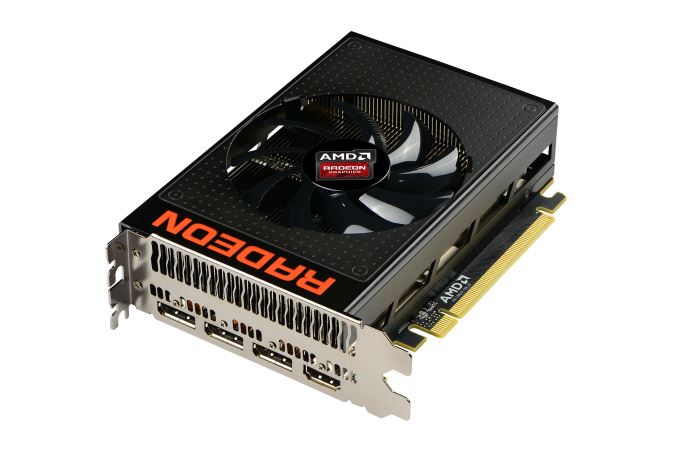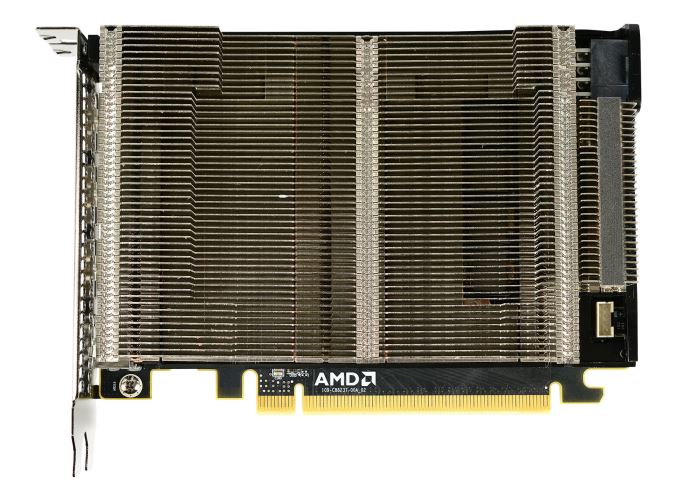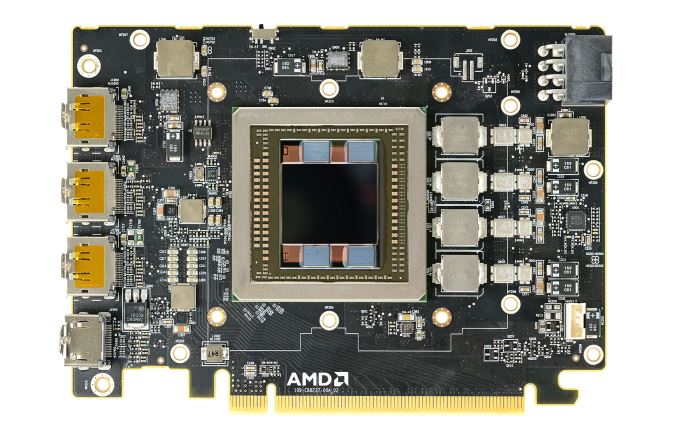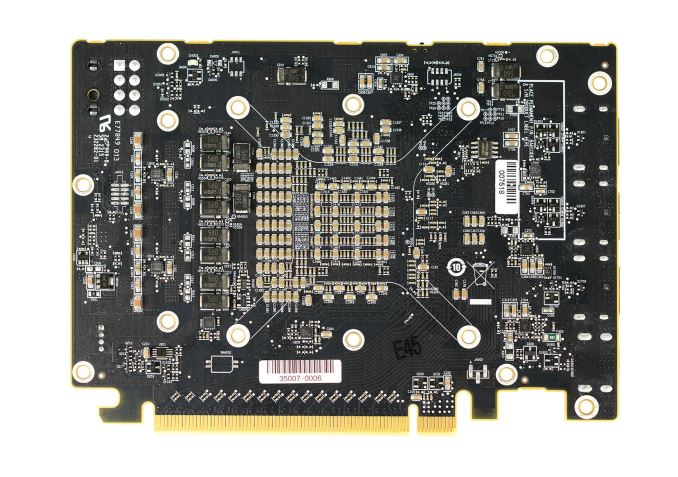The AMD Radeon R9 Nano Review: The Power of Size
by Ryan Smith on September 10, 2015 8:00 AM ESTMeet The Radeon R9 Nano
6 inch video cards are by no means a new thing in the GPU space, however these are traditionally lower-end products that need neither a large cooler nor an extensive power delivery system. As a result the R9 Nano is something of an interesting aberration, packing a lot more power and a lot more technology into half a foot of video card than what we normally see.
Starting as always from the top, the R9 Nano measures 6” long, which is actually a bit shorter than the full length the Mini-ITX standard allows. Responsibility for cooling the card falls to the R9 Nano’s new open air cooler, an aggressive design that has been specifically tailored to allow the card to effectively dissipate 175W of heat in such a small space.
The overall design of the R9 Nano’s cooler is best described as a combination open-air and half-blower hybrid. The design is technically open-air, employing a single axial fan to cool the card. However with only a single fan AMD has been able to align the heatsink fins horizontally and then place the fan in the center of the heatsink. The end result is that roughly half of the heat produced by the card is vented outside of the case, similar to a full blower, while the other half of the heat is vented back into the case. This reduces (though doesn’t eliminate) the amount of hot air being recycled by the card.
The heatsink itself is composed of aluminum and runs virtually the entire length of the card. This is technical a two-piece heatsink, with the primary heatsink composing the bulk of the card, while a much smaller secondary heatsink it found towards the far end of the card and mounted on top of a heatpipe.
Drilling down, we find that the primary heatsink is fed by a combination vapor chamber and heatpipe design. A copper vapor chamber serves to draw heat away from the Fiji GPU and HBM stacks, and then heatpipes are used to better distribute heat to the rest of the heatsink. The use of a vapor chamber in the R9 Nano makes a lot of sense given the fact that vapor chambers are traditionally the most efficient heatsink base type, however the R9 Nano is also unique in that we typically don’t see vapor chambers and heatpipes used together. Other designs such as the high-end GeForce series use a single large vapor chamber across the entire heatsink base, so among reference cards at least the R9 Nano stands alone in this respect. In this case given AMD’s design goals for size and noise, a vapor chamber will play a big part in helping the small card effectively and quietly dissipate 175W.
As for the physical PCB itself, as we can see AMD made it a relatively packed card in order to get the R9 Nano down to 6 inches. Compared to the R9 Fury X reference board, the biggest change here is that AMD has removed a fair bit of power circuitry to save space. By our count there are 4 VRM phases to feed the Fiji GPU, as opposed to the 6 found on R9 Fury X. Power delivery is handled by a single 8-pin PCIe power socket, which is becoming increasingly common, replacing the 2x 6-pin setup for 150W-225W cards.
Meanwhile to further shrink the overall PCB footprint, AMD has moved some of the remaining power delivery circuitry to the back of the card. The front of the card still contains the inductors and heat-sensitive MOSFETs, while a number of capacitors are on the rear of the card (and is why you won’t find a backplate).
Finally, for display I/O R9 Nano is unchanged from R9 Fury X. This means we’re looking at a DVI-free design, with 3x DisplayPort 1.2 and 1x HDMI 1.4 port all along a single row of the I/O bracket. Buyers looking to put together HTPCs will want to be especially mindful of the HDMI 1.4 port; while it's not necessarily a deal-breaker, it does mean that the R9 Nano can't fully drive 4Kp60 TVs, which are slowly but surely becoming more common.
Overall AMD is rather confident in their design for the R9 Nano. The heatsink is built to efficiently dissipate more heat than the 175W the card requires (despite the small size), and as a result we never see the R9 Nano thermally throttle under normal operation. The card’s thermal throttle point is 85C, and in our testing the card never passed 75C, exactly as AMD promised us. What ends up limiting the R9 Nano’s performance then is exactly as expected: the power throttling.
















284 Comments
View All Comments
palindrome - Thursday, September 10, 2015 - link
Such a double standard... If that is the case why does the Titan exist? The same can be said with ANY halo card. Being top of the market is going to cost more for consumers. It has ALWAYS been this way. Don't sit there and pretend that Nvidia wouldn't have done the exact same thing, if not worse, when it comes to pricing this product.Kjella - Thursday, September 10, 2015 - link
Having the absolutely fastest card possible for the performance freaks is quite different from having the fastest card in a niche that clearly values other attributes over maximum performance. Best battery life in a laptop is valuable. Best battery life in a gaming laptop, not so much. Or if you prefer car analogies, best compact car for pulling a trailer.palindrome - Thursday, September 10, 2015 - link
Your analogy is terrible. A better analogy would be comparing cars that are built for handling and all around performance like the M3 or WRX STI vs big HP cars like the Camaro, Mustang, or Challenger.Peichen - Thursday, September 10, 2015 - link
You can just get the GTX970 and overclock to make up the 20% difference. GTX970 easily go to 1450Mhz boosted from stock 1178MHz boosted.palindrome - Thursday, September 10, 2015 - link
The 970 mini cards don't have the same overclocking potential as the standard ones. Also, the HSF setup on those mini cards sound like a miniature leaf blower when you overclock them. The "efficiency" also goes out the window.Also, overclocking doesn't do much to improve 4K performance on those.
nikaldro - Thursday, September 10, 2015 - link
It's not like this card is good for 4K eitherpalindrome - Thursday, September 10, 2015 - link
It is fine if you don't just max all the settings. Anyone who ACTUALLY games at 4K knows that max settings on every game is a pipe dream at this point in time.TallestJon96 - Thursday, September 10, 2015 - link
It's an interesting product, but is just short of being great.If it was $500 it would be great.
If it came out 6 months ago, it would be great.
If it was built on 20nm, and had corresponding power reductions, it would be great.
If it performed 10% better, it would be great.
But it's not, it's just ok. As of right now, 99% of people would be better suited with either a 970, or 980 ti.
lmcd - Saturday, September 12, 2015 - link
It's a great product for its niche target. At this point neither company will likely release a "great" product because they want their money's worth.SeanJ76 - Thursday, September 10, 2015 - link
What a joke!! 650$ and it doesn't even beat the 500$ 980GTX!!